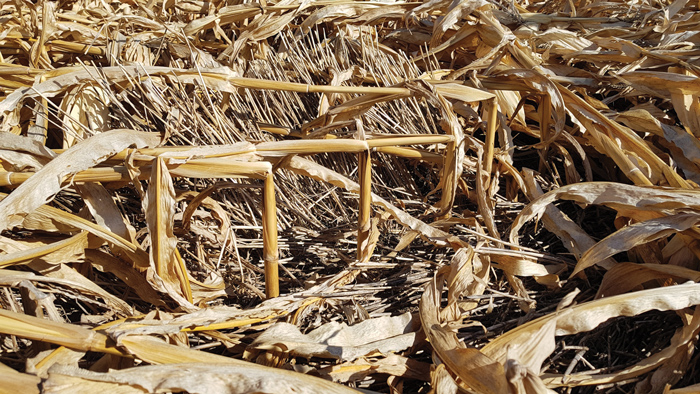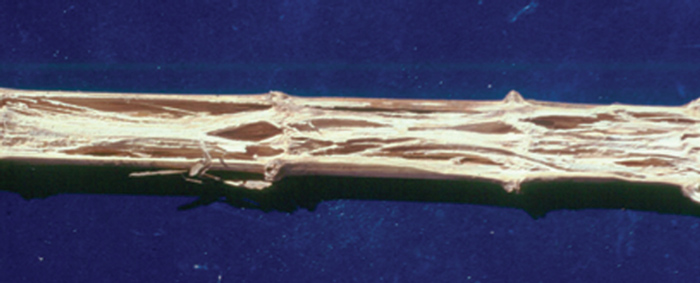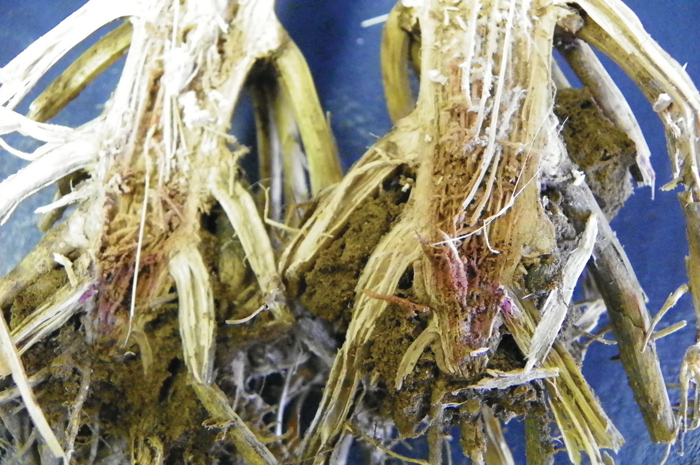
ARC-Grain Crops,
Potchefstroom
 Dr Belinda Janse
Dr Belinda Janse van Rensburg,
ARC-Grain Crops,
Potchefstroom
The most commonly reported fungal stalk rots of maize in South Africa are Diplodia, Fusarium, Gibberella and charcoal stalk rot. The only bacterial stalk rot on maize is termed bacterial whorl and stalk rot or more commonly known as kooksiekte.
These stalk rots are each caused by different organisms which vary in importance and prevalence due to prevailing climatic conditions within a specific season. In this series of three articles, the causal organism, economic importance, symptoms, epidemiology and control strategies for each of these stalk rots will be discussed. In this first article Diplodia and Gibberella stalk rot will be covered.
Diplodia stalk rot
Diplodia stalk rot is caused by the fungus Stenocarpella maydis (syn. Diplodia maydis) – with the primary host being maize.
Economic importance
This fungal pathogen is common in all maize-producing areas throughout South Africa. The disease manifests itself in seasons with early rainfall and persistent hot, late season droughts. It can be very damaging, resulting in plant lodging and reduced grain fill. Diplodia stalk rot causes yield reductions by reducing nutrient and moisture uptake from the roots and leaves to the ears during grain fill. This sink (the ear) extracts sugars from the stalk under stress, which further predisposes the stalk (the source) to increased fungal growth which in turn further reduces nutrient uptake.
The onset of windy conditions whilst plants are drying, results in lodging (Photo 1) and further economic losses as ears have to be picked up by hand. Estimated annual yield losses of 5% to 20% may occur due to Diplodia stalk rot and lodging, depending on the disease severity.

Symptoms
External stalk rot symptoms are extremely difficult to see at first, but will appear several weeks after silking (depending on disease severity). Initial external symptoms are when the leaves of infected plants wilt, become dry and appear greyish green. The lower stalk internodes become brown and spongy and small, black fruiting bodies (pycnidia) cluster near the nodes of the rind. The rind may also be covered by a white mycelial growth. The stalk pith discolours slightly and disintegrates (Photo 2) with vascular bundles remaining intact. This weakening of the stalk predisposes plants to lodging during strong winds and rain prior to harvest.

Epidemiology
The fungus overwinters as mycelia in maize stubble (buried or on the soil surface). Under warm, moist conditions pycnidia develop, releasing spores which are spread by wind and rain to the infection sites (generally the ear primordia on the lower stalk). Infections of plants occur mainly through the ear primordia behind each leaf sheath, the crown and roots. Infection usually takes place two to three weeks after silking under favourable conditions. Dry early season conditions followed by rain during silk formation favour Diplodia ear rot, while a wet early season followed by drier conditions or heat stress is likely to result in more severe Diplodia stem rot.
Control
- Crop rotation
Crop rotation reduces Diplodia inoculum development by allowing maize stubble to break down before the next maize planting, which results in lower stalk and ear rot infections. Soybeans are a good alternative crop in a rotation programme followed by groundnuts, wheat and dry beans. Crop rotation reduces inoculum levels in two ways. Firstly, maize is the only reported host crop of S. maydis, resulting in a break in the epidemiological cycle of the fungus by removing the host for a season. Secondly, maize stubble which has been on the soil surface for 24 months loses its integrity due to saprophytic breakdown, resulting in an inability to support pycnidia and mycelial survival. - Stubble removal versus conservation tillage practices
Removal of infected surface maize stubble by ploughing, grazing or in extreme cases burning, reduces inoculum load in a field. Caution should be exercised when using conservation tillage practices where stubble is retained on the soil surface. Crop residues left on the soil surface favour the survival of the pathogen from one season to the next, leading to a build-up of primary inoculum. However, hybrids with some resistance to Diplodia stalk rot can be used in conjunction with these conservation tillage practices. - Nutrients
High N:K (high nitrogen; low potassium) ratios increase the severity of stalk rot whereas a low ratio leads to a reduction in the disease. Stalk rot is reduced with increasing K at low N levels. K does not affect stalk rot at moderate N levels, but increases with K when N is high. Furthermore, when K is low, N levels do not affect disease, but moderate to high K and increased N enhance stalk rot. - Stress reduction
Diplodia stalk rot is a stress-related disease. Drought stress can be reduced by adjusting planting dates to avoid stress periods at grain fill, while reduced plant populations also reduce stress levels. - Fungicides
There are no fungicides in South Africa registered specifically against this disease and the economics of spraying for it is questionable. It has, however, been found that a good full protection spray programme for leaf diseases improves standability, since plant sugars from the stalks are not diverted for grain filling.
Gibberella stalk rot
Gibberella stalk rot is caused by the Fusarium graminearum species complex (FGSC) – with the primary crop hosts other than maize being oats, barley, rye, sorghum and wheat.
Economic importance
This stalk rot is a common problem in maize production areas worldwide, including South Africa. Gibberella stalk rot can cause extensive economic losses due to premature plant death and interference with translocation of water and nutrients during grain fill, resulting in poor grain fill and lodging of plants due to weakened stems. Poor grain fill is due to the effect of the fungal growth on the disruption of xylem and phloem tissues in the stalk. Although it is difficult to estimate precise yield loss due to Gibberella stalk rot, extensive damage (lodging) is known to occur during favourable environmental conditions. Lodging complicates mechanical operations, necessitating the picking up of plants and hand harvesting, which increase time, labour and financial constraints.
Symptoms
Symptoms of Gibberella stalk rot are similar to those of other stalk rots, but it is the pink/red discolouration that is diagnostic (Photo 3). Affected plants wilt, the leaves change from light to dull green and the lower stalks become straw coloured. The internal pith disintegrates, leaving only the vascular bundles partially intact. The disintegration of stem tissue causes stem lodging and rotting of the root system which lead to root lodging. Small, round, black fruiting bodies (perithecia) may be produced superficially on the stalks, often at the internode.

Epidemiology
Under warm, wet conditions, the perithecia produce ascospores that are disseminated by wind and may infect maize plants. Inoculum may also be produced as conidia during the summer. Stalk infections usually occur shortly after pollination, developing at the origin of the leaf sheaths or around the brace roots. The fungus may also infect through the roots and grow up into the lower stem.
Control
- Crop rotation
Crop rotation with legume crops or sunflowers will allow maize stubble to break down. With less maize stubble, inoculum can thus be reduced. Recently published work indicates that some
of these legume crops can act as hosts for the FGSC to survive on, which may change the crops we rotate with completely. This still needs to be confirmed locally. - Resistance
Hybrids with resistance to other stalk rots such as Diplodia may also be resistant to Gibberella stalk rot. Although a lot of effort has been made to select hybrids with stalk rot resistance, the main consideration is still yield. Genotypes with higher yields tend to have bigger ears, which act as large sinks for carbohydrates in the plants. The larger ears result in reduced carbohydrate levels in the lower stem, predisposing the plant to stalk rot. Therefore the balance between breeding for resistance to stalk rot and breeding for high yield is delicate. - Nutrients and stress reduction
Cultural practices that reduce plant stress also reduce incidence of stalk rot. Common stress conditions include high nitrogen, low potassium fertility, high moisture in the mid to late season after a dry early season as well as moisture stress early in the season and during grain fill. A high incidence of leaf diseases reduces the photosynthetic area of the plant, resulting in further plant stress. Physical damage (insects or hail) that creates wounds allowing the pathogen to enter the maize plant, may also predispose the plant to stalk rot. - Chemical control
There are no fungicides available for the control of Gibberella stalk rot. However, fungicide applications for the control of leaf diseases may be beneficial in reducing stress on the plant, thus lessening stalk rot severity and ultimately lodging.





























